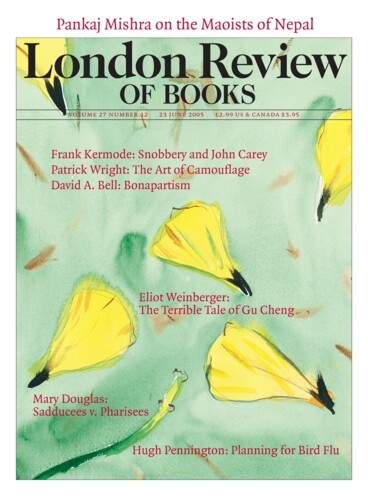We acquire mementos: an Eiffel Tower cigarette lighter, a mug from Margate, Michelangelo’s David on a key-ring. All say, in one way or another: ‘I was there.’ It is not just airport art and souvenir-shop knick-knacks that commemorate time in foreign parts. Trophies brought home by Grand Tourists and modern travellers – bits of marble and views of Venice, archaeological finds, sculpture hacked from ancient monuments, exotic pots and textiles – all are mementos as well as art-loot and museum specimens.
Souvenirs, a broader category than art, offer a commentary on cultural, political and economic relations. But while they may on the surface seem to say pretty clearly what the makers and buyers thought of each other, they are, at another level, enigmatic. Views from Africa, a very small, very engaging exhibition at the British Museum until 24 July, displays a selection from a rich source of souvenirs: it shows things brought out of the continent over the last five hundred years. Carvings in wood and ivory, bronze figures and plaques, and masks of several sorts. Mostly they show Europeans, and most of them were made for Europeans. Here you have the reverse of the Orientalist coin: in these works it is the pinko-greys, not the browns and blacks, who are shown as exotic stereotypes. A label on a case of 20th-century masks by the Chewa people of Malawi says that the makers regarded foreigners as ‘intelligent and successful but shrewd and dangerous’.
The oldest pieces on show – a 16th-century ivory saltcellar, a brass sculpture of a European soldier and brass plaques made as palace decorations – are skilled work which needed rich patrons. The Oba of Benin allowed his craftsmen to make souvenirs for Europeans: like Sèvres porcelain, their work was a commercial product made under royal patronage. The buyers influenced the objects in other ways, too: brass came from bracelets brought by European traders, and the soldiers represented are European mercenaries.
Two carved ivory tusks made by the Kongo people in the 19th century show the customer apparently dictating subject-matter. One of them has a long procession of figures – including animals, hunters, Europeans and shackled slaves – carved in deep relief. The other is engraved rather than carved with caricatures derived from the work of European illustrators such as the cartoonist Caran d’Ache.
In the 20th century there was a market for local carving among colonial expatriates. A Yoruba piece from the 1940s of a European official, complete with pith helmet and fly whisk, flanked by African policemen, all three figures mounted on a wheeled cart, is cruder than some of the earlier pieces; it’s a bold, lively sculpture which could also be a toy. You feel that the carver has the measure of the colonial official. Is there an element of caricature? I don’t think so, but the more awareness the artist shows of the subject the more difficult it is to be sure of his attitude towards it.
In a final case of masks, which were made for use rather than trade, the pieces are more direct; these Europeans have bright red faces. As with stage costumes, the need for things to be effective in a ceremony demands broader gestures. One mask is of Charlie Chaplin, created by an old man with early memories of one of Chaplin’s films. In the masks, more even than the carvings, you get a sense of the liberation some European artists felt when, local springs of innovation having run dry, they turned to art from elsewhere for inspiration. Here were representations of things which were unlike anything European art had ever done, or which it had perhaps just long forgotten how to do.
The theme linking the assemblage of objects in Views from Africa is the European as subject-matter – mainly the European male, although there is a fine, dumpy little carving of Queen Victoria, which is reproduced here. Enlarge the head a few dozen times and you have something very like one of Matisse’s big bronze portrait heads – the same exaggeratedly round cheeks, the same dominant nose and, because it is carved from dark wood, the same dark brown colour. But, as a print in the exhibition shows, this carving is also very like iconic photographs of the Queen Empress. The knees-together, forward-facing pose – a pose from Egyptian sculpture – was sustained in Africa. It happened to fit very well with the formal stances of hereditary rulers. Insurgent revolutionaries may invade a palace and lounge about on a throne; once they are in power they sit up straight.
The extent to which we respond to these objects as art rather than as evidence is an acknowledgment of the role African art played in freeing European art from its own past. The therapeutic session did not last all that long, but it changed permanently the status of pieces like these. The masks remind you that when art is created for an occasion it not only often is, but usually ought to be, ephemeral. There is a tension between the desire to make something permanent and the perception that the world is already overloaded with objects. The destruction of ephemeral art makes way for new creation. Artists profit from empty niches. Collectors, souvenir hunters and museums fill them.
Send Letters To:
The Editor
London Review of Books,
28 Little Russell Street
London, WC1A 2HN
letters@lrb.co.uk
Please include name, address, and a telephone number.


